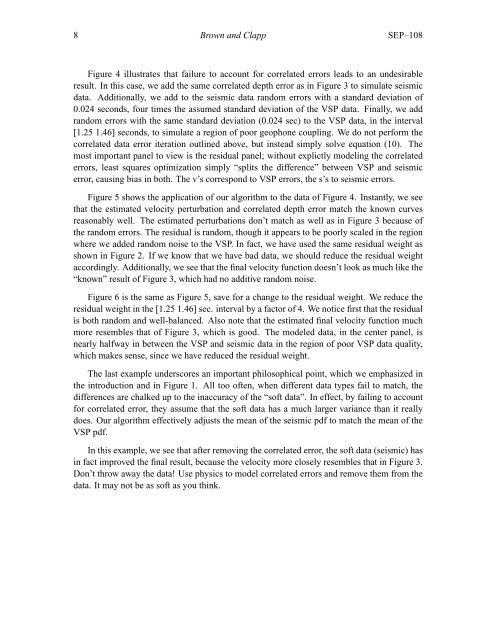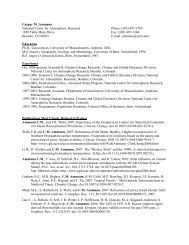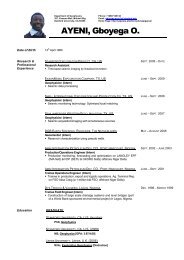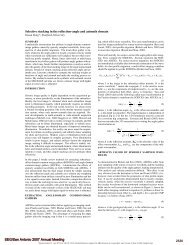pdf 349K - Stanford Exploration Project - Stanford University
pdf 349K - Stanford Exploration Project - Stanford University
pdf 349K - Stanford Exploration Project - Stanford University
You also want an ePaper? Increase the reach of your titles
YUMPU automatically turns print PDFs into web optimized ePapers that Google loves.
8 Brown and Clapp SEP–108<br />
Figure 4 illustrates that failure to account for correlated errors leads to an undesirable<br />
result. In this case, we add the same correlated depth error as in Figure 3 to simulate seismic<br />
data. Additionally, we add to the seismic data random errors with a standard deviation of<br />
0.024 seconds, four times the assumed standard deviation of the VSP data. Finally, we add<br />
random errors with the same standard deviation (0.024 sec) to the VSP data, in the interval<br />
[1.25 1.46] seconds, to simulate a region of poor geophone coupling. We do not perform the<br />
correlated data error iteration outlined above, but instead simply solve equation (10). The<br />
most important panel to view is the residual panel; without explictly modeling the correlated<br />
errors, least squares optimization simply “splits the difference” between VSP and seismic<br />
error, causing bias in both. The v’s correspond to VSP errors, the s’s to seismic errors.<br />
Figure 5 shows the application of our algorithm to the data of Figure 4. Instantly, we see<br />
that the estimated velocity perturbation and correlated depth error match the known curves<br />
reasonably well. The estimated perturbations don’t match as well as in Figure 3 because of<br />
the random errors. The residual is random, though it appears to be poorly scaled in the region<br />
where we added random noise to the VSP. In fact, we have used the same residual weight as<br />
shown in Figure 2. If we know that we have bad data, we should reduce the residual weight<br />
accordingly. Additionally, we see that the final velocity function doesn’t look as much like the<br />
“known” result of Figure 3, which had no additive random noise.<br />
Figure 6 is the same as Figure 5, save for a change to the residual weight. We reduce the<br />
residual weight in the [1.25 1.46] sec. interval by a factor of 4. We notice first that the residual<br />
is both random and well-balanced. Also note that the estimated final velocity function much<br />
more resembles that of Figure 3, which is good. The modeled data, in the center panel, is<br />
nearly halfway in between the VSP and seismic data in the region of poor VSP data quality,<br />
which makes sense, since we have reduced the residual weight.<br />
The last example underscores an important philosophical point, which we emphasized in<br />
the introduction and in Figure 1. All too often, when different data types fail to match, the<br />
differences are chalked up to the inaccuracy of the “soft data”. In effect, by failing to account<br />
for correlated error, they assume that the soft data has a much larger variance than it really<br />
does. Our algorithm effectively adjusts the mean of the seismic <strong>pdf</strong> to match the mean of the<br />
VSP <strong>pdf</strong>.<br />
In this example, we see that after removing the correlated error, the soft data (seismic) has<br />
in fact improved the final result, because the velocity more closely resembles that in Figure 3.<br />
Don’t throw away the data! Use physics to model correlated errors and remove them from the<br />
data. It may not be as soft as you think.







